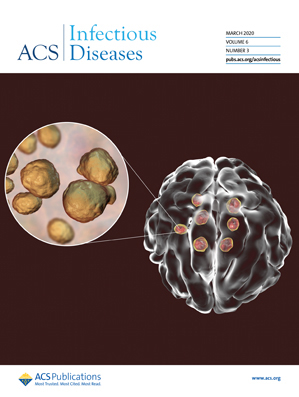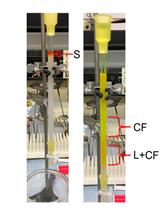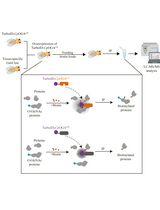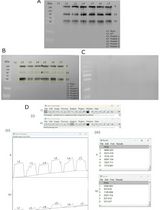- EN - English
- CN - 中文
Click Chemistry for Imaging in-situ Protein Palmitoylation during the Asexual Stages of Plasmodium falciparum
恶性疟原虫无性期原位蛋白质棕榈酰化的点击化学成像
发布: 2021年05月05日第11卷第9期 DOI: 10.21769/BioProtoc.4002 浏览次数: 5583
评审: Vasudevan AchuthanRakesh ChatrikhiAnonymous reviewer(s)
Abstract
Palmitoylation refers to the modification of the cysteine thiols in proteins by fatty acids, most commonly palmitic acid, through ‘thioester bond’ formation. In vivo, palmitoylation of proteins is catalyzed by palmitoyl acyltransferases (PATs or DHHC-PATs). Palmitoylation has recently emerged as a crucial post-translational modification in malarial parasites. The expression and activity of palmitoyl transferases vary across different developmental stages of the malarial parasite’s life cycle. The abundance of palmitoylated proteins at a given stage is a measure of overall PAT activity. The PAT activity can also change in response to external signals or inhibitors. Here, we describe a protocol to ‘image’ palmitoyl-transferase activity during the asexual stages using Click Chemistry and fluorescence microscopy. This method is based on metabolic labeling of a clickable analog of palmitic acid by parasitic cells, followed by CuAAC (Copper-catalyzed Alkyne-Azide Cycloaddition reaction) Click Chemistry to render palmitoylated proteins fluorescent. Fluorescence allows the quantitation of intracellular palmitoylation in parasite cells across various development stages. Using this method, we observed that intracellular palmitoylation increases as the parasite transitions from ring to schizont stages and appears to be most abundant during the schizont stages in Plasmodium falciparum.
Keywords: Protein palmitoylation (蛋白质的棕榈酰化)Background
Quantitation of the relative abundance of a known palmitoylated protein allows quantitation of intracellular palmitoyl-transferase activity. Palmitoylated proteins can be captured and quantitated using acyl biotinyl exchange chemistry followed by western blotting or mass spectroscopy. Quantitation can also be achieved by in-gel visualization of palmitoylated proteins rendered fluorescent after metabolic labeling and Click Chemistry (Martin, 2013). Previously, radiolabeled fatty acids were used to monitor the in-vivo palmitoylation of proteins; however, such methods do not allow visualization of palmitoylated proteins or imaging of global PAT activity in-situ. The method described here is a modification of procedures that use Click Chemistry with proximity ligation to study palmitoylation of proteins in cells (Hannoush and Arenas-Ramirez, 2009; Gao and Hannoush, 2014). This method has high sensitivity and reproducibility in our hands and can be reliably used to measure in-situ protein palmitoylation or palmitoyl-transferase activity at the ‘single-cell’ level. We have used it to study palmitoylation during different stages of malarial parasites. This method can be applied to the high-throughput screening of inhibitors of palmitoyl-transferases (also called DHHC-PATs; DHHC refers to Aspartate (D), Histidine (H), Histidine (H), Cysteine (C), a motif required for palmitoyl-transferase activity) by adapting the protocol to a multi-well format and using fluorescence as a readout.
Materials and Reagents
Consumables
Costar® 6-well clear TC-treated multiple-well plates (Individually Wrapped, Sterile, catalog number: 3516)
Cell culture dish, 150 mm (BD, catalog number: 353025)
2 ml microcentrifuge tubes (Tarsons, catalog number: 500020)
1.5 ml microfuge tubes (Tarsons, catalog number: 500010)
Glass slides (GEM Microscopy slides, catalog number: 051)
Coverslips (Blue star)
KimwipesTM (Sigma-Aldrich, catalog number: Z671584-1EA)
10 ml serological pipette (Falcon®, catalog number: 357551)
Powder-free gloves
Nail polish
3D7 strain of Plasmodium falciparum (MR4)
Human blood O+ (packed red blood cells) (Rotary Blood Bank)
AlbuMAXTM II (Thermo, catalog number: 11021037)
RPMI Media (Thermo, catalog number: 23400-021)
Chemicals and Reagents
Gentamycin (Sigma, catalog number: G1272-10ML)
DAPI ProLongTM Gold Antifade Mountant (Thermo, catalog number: P36966)
Sorbitol (Sigma, catalog number: S3889-500G)
Giemsa stain (Sigma, catalog number:48900-1L)
DMSO HybrimaxTM (Sigma, catalog number: D2650)
Hypoxanthine (Sigma, catalog number: H9377)
Triton X-100 (Sigma-Aldrich, catalog number: 93443)
Methanol (Sigma, catalog number: 34860)
DPBS or Dulbecco’s Modified PBS (Thermo, catalog number: 14190250)
Bovine Serum Albumin (Sigma, catalog number: A7638)
Glucose HybimaxTM (Sigma-Aldrich, catalog number: G5146)
Sodium bicarbonate/NaHCO3 (Sigma-Aldrich, catalog number: S5761)
Click Chemistry Reagents
17-Octadecynoic acid (Sigma, catalog number: O8382)
Oregon Green 488 Azide (Thermo, catalog number: O10180)
Copper Sulfate/CuSO4 (Sigma-Aldrich, catalog number: 451657)
Tris(2-carboxyethyl) phosphine hydrochloride/TCEP (Sigma-Aldrich, catalog number: C4706)
Stock Solutions
RPMI complete medium (1 L) (see Recipes)
5% Sorbitol solution (0.5 L) (see Recipes)
17-ODA stock solution (see Recipes)
Oregon Green 488 azide solution (see Recipes)
TCEP solution (see Recipes)
CuSO4 solution (see Recipes)
Permeabilization buffer (see Recipes)
Blocking buffer (see Recipes)
Triton X-100 10% solution (see Recipes)
Equipment
-80°C Freezer (Thermo)
Culture hood (Esco Class-II type Bio-safety cabinet)
37°C incubator (Automatic CO2 incubator)
Confocal microscope (Nikon A1)
Orbital shaker
Tabletop centrifuge (Eppendorf, model: 5180R)
Swing-bucket rotor (Eppendorf, catalog number: 5810718007)
Stainless-steel tweezers (Sigma, catalog number: T5915-1E, any good tweezers can be used)
Coplin jars (Eisco Labs, catalog number: BI0108PK3)
Procedure
文章信息
版权信息
© 2021 The Authors; exclusive licensee Bio-protocol LLC.
如何引用
Siddiqui, M. A. (2021). Click Chemistry for Imaging in-situ Protein Palmitoylation during the Asexual Stages of Plasmodium falciparum. Bio-protocol 11(9): e4002. DOI: 10.21769/BioProtoc.4002.
分类
生物化学 > 蛋白质 > 翻译后修饰
微生物学 > 微生物生物化学 > 脂质
您对这篇实验方法有问题吗?
在此处发布您的问题,我们将邀请本文作者来回答。同时,我们会将您的问题发布到Bio-protocol Exchange,以便寻求社区成员的帮助。
Share
Bluesky
X
Copy link













